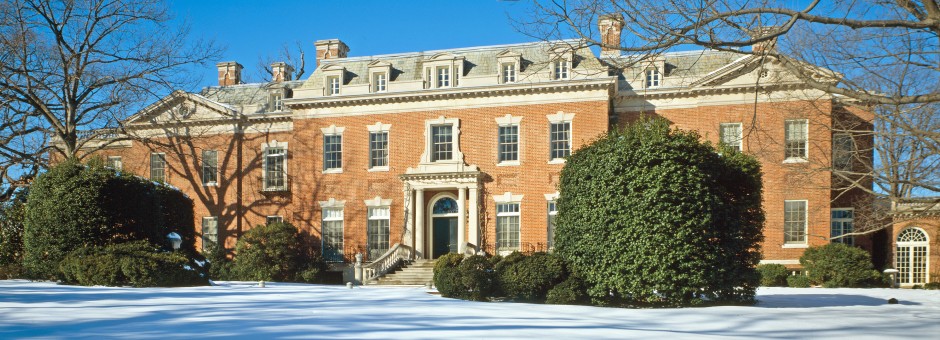Philip Johnson, perhaps best known for his Glass House, played an important role at Dumbarton Oaks by designing what is often called the Philip Johnson Pavilion, the gallery that houses the Robert Woods Bliss Collection of Pre-Columbian Art. The description of the pavilion from the Dumbarton Oaks website describes the back story of the building:
In 1959, the Blisses commissioned the architect Philip Johnson to design a pavilion for the Robert Woods Bliss Collection of Pre-Columbian Art. This building—eight domed circular galleries (having an unroofed fountain area at the center) set within a perfect square—recalls Islamic architectural ideas, and Johnson later credited the design to his interest in the early 16th-century Turkish architect, Mimar Sinan. The pavilion was built in the Bosque (or copse), one of the designed landscapes at Dumbarton Oaks, and Johnson employed curved glass walls to blend the landscape with the building. He later reminisced that his idea was to fit a small pavilion into an existing treescape, to make the building become part of the Bosque. Johnson maintained that he wanted the garden tomarch right up to the museum displays and become part of them,with the plantings brushing the glass walls and the sound of splashing water audible in the central fountain. Furthering this idea, Mildred Bliss suggested creating four interior glazed planter areas situated between the galleries and the fountain.
For a more detailed study of the pavilion’s design and construction, see the Museum’s online publication, Philip Johnson at Dumbarton Oaks.
The pavilion was a revolutionary design for the Dumbarton Oaks grounds. Its modern look and all glass design were — and still are — a stark contrast to the more conservative architecture typified by the other buildings on the estate. However, the unique new wing initially provided challenges to the museum due to engineering issues and strange acoustics.
While the glass walls are aesthetically pleasing and integrate the gallery with the exterior, exposure of light-sensitive artifacts to near constant sunlight proved to be a critical issue. Elizabeth Benson, former Curator of the Pre-Columbian Collection, notes in her oral history interview that Dumbarton Oaks needed to install “ultraviolet filtering walls” and curtains for the artifacts. She also mentions that lights were installed outside the building to shine in to cut down on nighttime reflections
because if you walked toward those curved windows in that lighted room, you looked like yourself coming at yourself in a funhouse mirror.
Benson, Richard Diehl and Jeffrey Quilter all recall the water problems the building initially had as well. According to Diehl, when he arrived for work one January morning, there was “perhaps a half an inch of ice on the inside of the glass on the Philip Johnson building all around it. And so we had to get all the objects out and then melt the water and get it out of there.” Quilter compared the building to the architectural masterpiece Fallingwater: “beautiful buildings, but engineering…disasters.”
One of the other quirks of the building is the sound effects. According to Benson
if you stand on one side and speak across, you sound loud to the person directly opposite to you. If you stand in the middle of the room, you come back at yourself, you scare yourself. Nobody else notices that. But we put things in the middle of the room really to keep people from having this experience of scaring themselves in there. And that’s how the plants got in there.
A quick look at the Philip Johnson Pavilion may raise questions about what connections such a building would have with a pre-Columbian collection. On initial observation, the building and its contents may seem discordant, but in reality, there is a harmony between the two. Both are prime examples of the vision of the Blisses, and the connection between the exhibits and the exterior garden evokes a sense of “oneness” with nature, something quite important to the cultures whose artifacts are on display.
The collection itself is seen as “particularly fine.” Benson characterizes it as
smaller than a lot of collections, yet it’s big enough to be shown as an entity and as a thing with various kinds of things in it. It has most of the important kinds of things, but I think it’s a very kind of beautiful introduction to pre-Columbian art for people who haven’t seen it before – it’s the finest thing to see first. And also if you know pre-Columbian art, it’s a real treat.
What’s more, 2013 is also the 50th anniversary of the Robert Woods Bliss Collection of Pre-Columbian Art at Dumbarton Oaks. For those in the Washington area, what better time to visit the collection? Be sure to check out the newly opened exhibit Inspiring Art: The Dumbarton Oaks Birthing Figure!








